It was all the fault of the whalers! No, not the modern ones -- we cannot blame them for this -- but the ancient seafarers who travelled far in sailing vessels in search of fortunes; fortunes embedded in the oily bodies of the great whales. These opportunistic plunderers came to the remote volcanic archipelago we now know as the Galapagos Islands. They were probably disappointed at first by the lack of fresh water, but what they did find was a remarkable supply of fresh meat in the form of the resident giant tortoises. Rolled on their backs these poor creatures could survive on-board for up to a year, meaning fresh meat for the whalers.
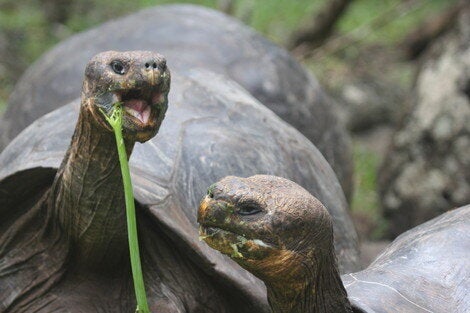
Galapagos Tortoises. Credit: M P Simmonds/HSI
From the 17th through to the 19th century, thousands of tortoises were carted away from the islands, and their populations have never recovered. Recent attempts to aid their recovery have been hampered by species introduced by visiting vessels, including rapacious goats who proliferated and ate the landscape. Vessels unintentionally brought rats, and whilst adult tortoises struggled in competition with the goats, their eggs and hatchling tortoises had no defence against the rats.
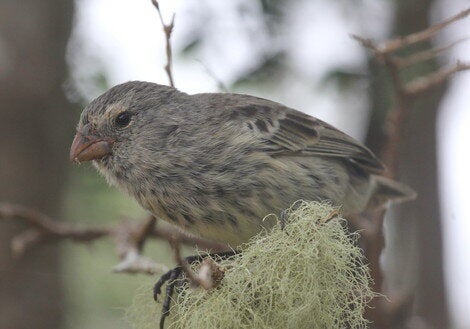
Darwin's Finch. Credit: M P Simmonds/HSI
Recently I was fortunate enough to visit the Galapagos Islands, now part of Ecuador, a visit that for me, like many biologists, was a dream come true. The islands still host amazing and unique wildlife and are the crucible of evolutionary theory. This is where Charles Darwin traveled on the Beagle, and the weird and wonderful variety of life he found inspired and underpinned his theory of evolution. Darwin's friendly little finches still greet visitors today, and so do the wonderfully named blue-footed boobies (a large seabird with bright turquoise webbed feet), hundreds of marine iguanas basking on the black coral rocks or running across the white sand, and a variety of sharks, turtles, Galapagos sea lions and more.
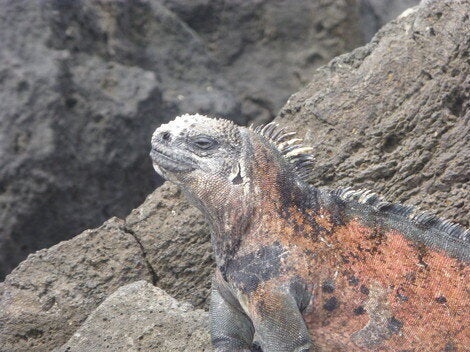
Marine Iguana. Credit: M P Simmonds/HSI
When Darwin left he took tortoises with him, mainly, I suspect, for his dinner rather than his studies. I saw many full grown and ancient adults in the tortoise 'ranches' on the islands of Santa Cruz and Floreana. Like many other visitors, I stood sadly in front of the already fading plaque in the Darwin Research Station that marks the passage from this life of Lonesome George, the last of the Pinta Island tortoises. Historically, different islands hosted different species (or subspecies) which over the millennia became adapted to the particular conditions on each island.
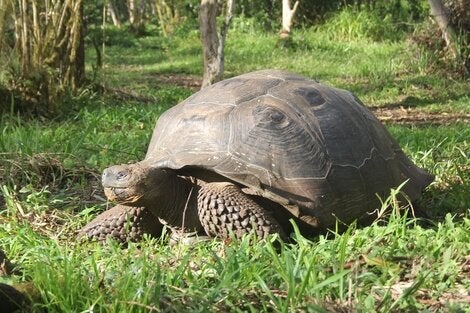
Giant Tortoise. Credit: M P Simmonds/HSI
A full grown male giant can exceed 300 kg (660lbs) and they are also very long-lived with instances of over 150 years known. Lonesome George achieved international fame before his death of natural causes in 2012. Considerable efforts were made to find a female of the same species on Pinta and elsewhere (as it was recently realised that the whalers had moved individuals of some of the sub-species between islands) but searches failed. Henry Nicholls's book, Lonesome George - the life and loves of a conservation icon - provides a window into the trials and tribulations of modern-day conservation, including conflicts with the growing local human population.
This is a theme also picked up in a recent excellent documentary on RadioLab and, despite my wide-eyed distraction with the local wildlife, I could not miss the potential for conflicts between the growing tourist industry and the wildlife that lured us all to this remote place. Ecotourism here as elsewhere offers great advantages to the local people but clearly must be carefully managed.
The giant tortoises and the great whales share linkages of history but in addition, they both are long lived, slow breeding and their size made them target for a cruel exploitation from which they have struggled to recover. Both life forms now face a myriad of modern threats. But there are of course also differences. The limited island ranges of the giant tortoises contrast with the vast oceanic ranges of the great whales. Each provides its own challenges.
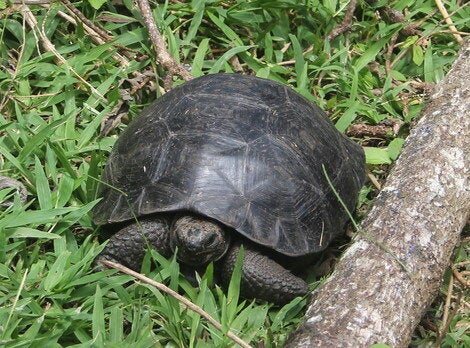
Young Giant Tortoise. Credit: M P Simmonds/HSI
But let's end on a positive note - there are baby tortoises on the Galapagos island of Pinzon for the first time in 150 years, following more than half a century of conservation efforts. The alien species have now all been removed and tortoise youngsters are hatching and surviving. Ten tiny newly hatched tortoises were found there in December, news so tremendous that it has just been reported in the leading international science journal Nature. Where ten can be found, hundreds more little tortoises are likely to be hiding amongst the lava rocks. So whilst the Pinta Island tortoises are no more, Pinzon again has a self-sustaining tortoise population.
Galapagos in Spanish, by the way, means 'tortoise' and 'tortoise', for my American friends, means land turtle. More importantly, the giants are coming back!
